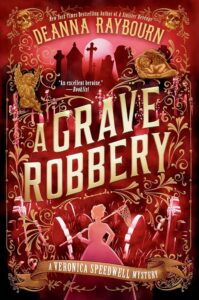Veronica Speedwell #9
 Whether she’s writing suspense or historical fiction, Deanna Raybourn is never anything less than completely entertaining. There’s a magic to the storytelling in her long-running Veronica Speedwell series that suspends time for the reader. In case you don’t know, Veronica is a lepidopterist (studies butterflies), and her partner, Stoker, is a gifted naturalist and expert taxidermist. There are mysteries involved, of course, but these are more adventure stories in the vein of Mrs. Pollifax or Elizabeth Peters’ Amelia Peabody books, and you, dear reader, can’t help but enjoy the ride.
Whether she’s writing suspense or historical fiction, Deanna Raybourn is never anything less than completely entertaining. There’s a magic to the storytelling in her long-running Veronica Speedwell series that suspends time for the reader. In case you don’t know, Veronica is a lepidopterist (studies butterflies), and her partner, Stoker, is a gifted naturalist and expert taxidermist. There are mysteries involved, of course, but these are more adventure stories in the vein of Mrs. Pollifax or Elizabeth Peters’ Amelia Peabody books, and you, dear reader, can’t help but enjoy the ride.
Veronica and Stoker are relaxing at home as this outing begins – they live on the grounds of Lord Rosemorran’s estate, pursuing their paying gig of cataloging his extensive collection of artifacts, art, and just plain oddities. As the book opens, a glass coffin containing a waxwork woman is delivered to their studio. It’s soon followed by Lord Rosemorran’s daughter, Rose, who has requested a wax figure like the “breathing” Sleeping Beauty she’s seen at Madame Tussaud’s. At the turn of the 20th century, Madame Tussaud’s was a unique and magical place – and the clockwork gears inside the sleeping beauty seemed miraculous to young Rose.
On inspection, however, Veronica and Stoker conjecture that the waxwork is probably an anatomical “Beauty.” In the absence of scarce human corpses, such figures were used to teach anatomy and the figures contained a complete set of organs. They send Rose away as they begin their examination, only to find to their horror that the wax beauty is actually a real woman who has somehow been preserved. Naturally, this upsetting discovery only spurs Veronica and Stoker to try and learn who the woman might have been.
They need reinforcements for such a search, and they call in their old cohorts Mornaday, a policeman, and J.J., an aspiring reporter. As a female reporter J.J. resents being relegated to the fashion beat and Veronica and Stoker have provided many meaty stories for her in past adventures, this book proving to be no exception.
One of the many joys of these books is the relationship between Veronica and Stoker, which is a truly loving one, ignited by the former’s fearless personality. Despite being a woman in Victorian London, she goes where she wants and does what she pleases, which not surprisingly often leads to trouble. Her present investigation includes a trip on the Necropolis Railway – a Victorian notion to relieve overcrowded cemeteries. Coffins and the mourners traveled on an underground train to resting places a bit out of London proper, providing quite the atmospheric setting for this adventure.
The detective work undertaken by Veronica and Stoker is clever and intelligent and requires the couple to call upon and grill a variety of colorful supporting characters. A tale like this needs both a compelling villain and a sympathetic victim, and Raybourn provides them. She’s equally great at pacing a story and builds a relentless momentum that propels her heroic couple forward. As the two of them race ahead to a solution, Veronica thinks to herself: “We were forty centuries removed from the days when it was necessary to take up a spear to stalk one’s dinner, and yet all the thrill of that atavistic hunt thrummed in my veins.” It may thrum in your veins as well, dear reader, as Veronica arms herself with a stiletto and goes forth to Victorian London to settle scores. As she would say, Excelsior! — Robin Agnew